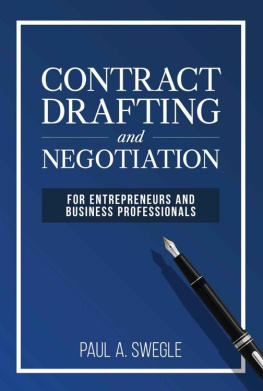Drafting Documents for use in Court:
Affidavits & Witness Statements
by Paul Venus, Partner Holding Redlich Lawyers
B.com, LLB, LLM, Accredited Litigation Specialist - Queensland Law Society
Solicitor of the High Court of Australia and the Supreme Courts of New South Wales, Queensland, South Australia and the Northern Territory of Australia.
.
Smashwords Edition
Copyright Paul Venus 2012
The moral right of the author has been asserted.
All rights reserved.
Without limiting the rights under copyright law reserved above, no part of this publication may be reproduced, stored in or introduced into a retrieval system or transmitted, in any form by any means electronic, mechanical, photocopying, recording or otherwise), without the prior written permission of the copyright owner. Requests should be emailed to paul.venus@holdingredlich.com
Ebook Formatting by www.ebooklaunch.com
1 INTRODUCTION
1.1 What this work is about
1.2 Affidavits and statements
1.3 Trial by affidavit or statement
1.4 What the court rules require
1.5 Is oral evidence better that affidavit or statement evidence?
1.6 Why take affidavit or statement evidence?
1.7 When not to take an affidavit or statement
1.8 Whose job is it to prepare a statement or affidavit?
2 WHEN IS AN AFFIDAVIT OR STATEMENT REQUIRED?
2.1 Introduction
2.2 Relationship between the UCPR and existing rules
2.3 Affidavits as pleadings
2.4 Interlocutory applications
2.5 Evidence
2.6 Formal affidavits
2.7 Affidavits in support of applications to strike out pleadings
2.8 Affidavits in support of summary disposal of proceedings
2.9 Affidavits in support of interlocutory relief
2.10 Affidavits in support of judgment and enforcement of judgment
2.11 Other matters
3 PREPARATION FOR TAKING A WITNESS STATEMENT OR AFFIDAVIT
3.1 Summary
3.2 Introduction
3.3 Brainstorming
3.4 Cast of Characters
3.5 An evidentiary note: Competence of witnesses
3.6 Preparation for the meeting with the witness
3.7 Organising documentation
3.8 Chronologies
3.9 Timelines
3.10 Obtaining agreement of the witness
3.11 Payments to witnesses
3.12 Plan the interview
3.13 Preparing a draft statement before the interview
4 INTERVIEWING THE WITNESS
4.1 Summary
4.2 Introduction
4.3 Logistical issues
4.4 Recording the witness interview
4.5 Interviewing more than one witness at a time
4.6 Phases of an interview
4.7 Basic information to provide to the witness at the interview
4.8 Focus on the witness
4.9 Know your case
4.10 Get the witness to open up and use follow up questions
4.11 Conversations
4.12 Write it all down regardless of what is said!
4.13 Be vigilant - look out for evasion and listen for ambiguities
4.14 Avoid framing questions in the negative
4.15 Think about trial
4.16 Test the witness
4.17 The problem of memory
4.18 When to interview a witness
4.19 Use of complex questions
4.20 Showing documents to a witness during an interview
4.21 Other sources of information about events and facts
4.22 Your opponents witnesses
4.23 Aboriginal witnesses
4.24 Preparing the draft statement or affidavit
4.25 Evaluate the witness
4.26 Witnesses discussing their affidavit or statement after it is made
4.27 Do not coach the witness
5 SUBSTANCE OF THE AFFIDAVIT
5.1 Summary
5.2 Introduction
5.3 Relevance
5.4 Irrelevant material
5.5 Contents of the Affidavit or statement
5.6 Hearsay affidavits
5.7 Use the words of the witness
5.8 Record conversations in direct speech
5.9 Avoid being responsive to pleadings or other witness statements
5.10 Check the witness statement or affidavit for inaccuracies
5.11 Make sure the witness can swear to the facts
5.12 Scandalous, irrelevant or otherwise oppressive material
5.13 Ethical duties concerning affidavits
6 EVIDENTIARY ISSUES
6.1 Summary
6.2 Introduction
6.3 Try to avoid Hearsay
6.4 Exceptions to the Rule Against Hearsay
6.5 Best evidence rule
6.6 Speculation and opinion
6.7 Submissions
7 PRIVILEGE AND AFFIDAVITS AND STATEMENTS
7.1 Summary
7.2 Introduction
7.3 Importance of the laws concerning privilege
7.4 Professional Legal Privilege - the Evidence Act 1995
7.5 Dominant purpose test
7.6 Loss of legal professional privilege
7.7 Consent and related matters
7.8 Joint clients
7.9 Misconduct and other matters
7.10 Dealing with without prejudice communications in statements and affidavits
8 EXPERT REPORTS
8.1 Summary
8.2 Introduction
8.3 The Evidence Act 1995
8.4 Who should be engaged as an expert
8.5 Relationship of the expert to the party
8.6 Using overseas experts
8.7 Guidelines for expert witnesses
8.8 Briefing materials for the expert
8.9 Language of the expert report and testimony
9 DRAFTING
9.1 Summary
9.2 Introduction
9.3 Identifying purpose
9.4 Remember who the audience is going to be
9.5 Arranging and ordering information
9.6 Structure
9.7 Using Introductions and Summaries
9.8 Sentence length
9.9 Use Informative Headings
9.10 Use normal punctuation
9.11 Pictures, Tables, graphs, diagrams and charts
9.12 Style
9.13 Using definitions
9.14 Using technical terms and terms of art
9.15 Drafting in the proper tense
9.16 Layout and design
10 FORM AND PRESENTATION
10.1 Summary
10.2 Introduction
10.3 Name of the deponent
10.4 Address of the deponent
10.5 Dates, sums and other numbers
10.6 Physical condition of the affidavit or statement
10.7 Margins and spacing
10.8 First Page of the document
10.9 Footers
10.10 Use paragraphs
10.11 Annexures and exhibits
10.12 Alterations
10.13 Signing of the affidavit or statement
10.14 Form of affidavit
10.15 Sample of form in the Federal Magistrates Court
10.16 The form of an affidavit in the Federal Court of Australia is as follows:
10.17 For the Supreme Court of New South Wales: Sample of Form in the Supreme Court of New South Wales:
11 TAKING AN AFFIDAVIT
11.1 Summary
11.2 Introduction
11.3 Evidence Act 1995 (Cth)
11.4 Evidence Act 1995 (NSW)
11.5 Oaths Act 1900 (NSW)
11.6 Oaths Act 1867 (QLD)
11.7 Australian Capital Territory
11.8 Northern Territory and South Australia














